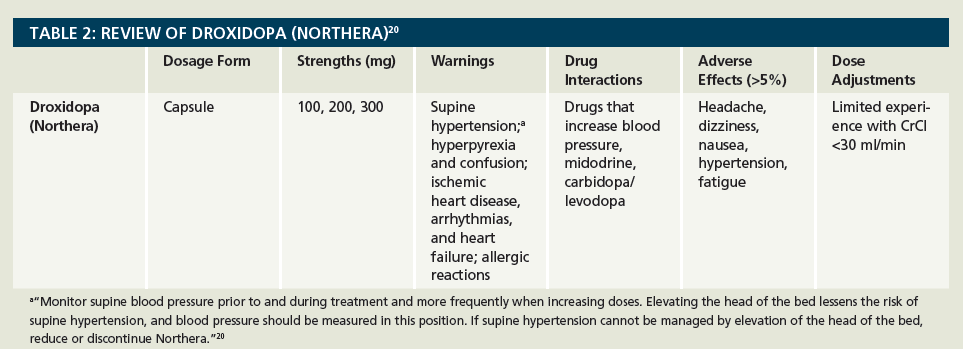Publication
Article
Pharmacy Practice in Focus: Health Systems
Droxidopa: Managing Neurogenic Hypotension
Though clinically significant, NOH has had few treatment options.
Though clinically significant, NOH has had few treatment options.
By definition, orthostatic hypotension (OH) is a persistent decrease in systolic blood pressure of at least 20 mm Hg or diastolic blood pressure of at least 10 mm Hg within 3 minutes of standing.1 Although there are several common causes of OH, it may also occur in association with diminished autonomic response. In the presence of primary neurodegenerative diseases of the autonomic system—such as Parkinson’s disease, multiple system atrophy, or pure autonomic failure—the result is neurogenic orthostatic hypotension (NOH).2,3 Despite the distinctiveness of these disease states, the pathophysiology is similar in the failure to produce appropriate norepinephrine response to postural change resulting in blood pressure dysregulation.1 As a result, patients with NOH will experience hypotensive symptoms upon change in body position and potentially severe hypertension in the supine position.3
NOH is a rare subtype of OH. Therefore it is classified as an orphan disease (a disease affecting fewer than 200,000 people nationwide).4,5 Nevertheless, the symptoms of NOH can be debilitating and negatively impact a patient’s quality of life. Symptomatic NOH is characterized by dizziness, lightheadedness, and presyncope which result from inadequate vasoconstriction and blood pressure reduction with postural change due to inadequate norepinephrine utilization or release.6 Activities of daily living that require walking or standing can be significantly affected by the symptoms of NOH.7 Additionally, OH is an independent risk factor for falls and syncope,8,9 both of which can lead to feelings of isolation and loss of independence.10 Further complicating the clinical picture, incident coronary artery disease, stroke, and heart failure are associated with OH,11,12 and it is an independent risk factor for mortality.13,14
Despite the clinical significance of NOH, there are few treatment options. Until the approval of droxidopa (Northera) in February 2014,15 there was only 1 FDA-approved treatment. In 1996, midodrine (ProAmatine), an oral alpha-1-adrenoceptor agonist, received OH treatment approval based on its effectiveness in increasing upright blood pressure.16 The approval of midodrine, however, was conditional upon completion of phase 4 studies that also demonstrated improvement of symptoms (these studies have only recently commenced).17,18 Due to the multiple consequences associated with NOH symptoms, the main goal of treatment is to reduce symptoms and improve quality of life. Consequently, the FDA supports symptom improvement, as opposed to increase in upright blood pressure, as the primary outcome to assess therapy effectiveness for NOH.3
Droxidopa was developed under the FDA recommendations described above and became commercially available in the United States on September 2, 2014.19 Upon oral intake, it is absorbed and converted to norepinephrine by dopa-decarboxylase, both peripherally and centrally.3 This enzyme is the same one responsible for converting levodopa to dopamine in the treatment of Parkinson’s disease (see Online Figure).3 Droxidopa is indicated for symptomatic NOH due to primary autonomic failure, dopamine betahydroxylase deficiency, and nondiabetic autonomic neuropathy.20
Figure

The medication is dosed starting at 100 mg 3 times daily (every 4 hours) with or without food. It is important that the last dose is administered no later than 3 hours before bedtime to avoid supine hypertension; however, in clinical trials, the last dose was given at least 4 hours before bedtime, or no later than 5 pm.17,20,21 The recommended starting dose is 100 mg 3 times a day, with suggested dose increases of 100 mg 3 times a day every 24 to 48 hours, up to a maximum recommended dose of 600 mg 3 times a day.20,22 Titrating the dose to symptomatic response and periodically monitoring for continued effectiveness of the medication is recommended.
Current studies have not demonstrated statistically significant effectiveness beyond 2 weeks. In trial 306b, one of the phase 3 trials assisting with FDA approval, 40% of patients achieved the maximum recommended dose (1800 mg/day), with approximately 37% receiving doses ranging from 300 to 400 mg 3 times a day.23,24 It is also postulated that patients receiving carbidopa/levodopa for the treatment of Parkinson’s disease may need adjusted doses of droxidopa due to potential drug interaction. Based on limited data, it is uncertain if clinical doses of carbidopa will inhibit the conversion of droxidopa to norepinephrine in the periphery leading to a need for higher doses of droxidopa.3 This means that continued monitoring and titration to symptomatic improvement is needed.
The results of 2 randomized, placebo-controlled trials investigating droxidopa in patients with primary autonomic failure—including Parkinson’s disease, multiple system atrophy, pure autonomic failure, and nondiabetic autonomic neuropathy—were recently published.17,21 Both studies utilized the Orthostatic Hypotension Questionnaire (OHQ) tool to assess NOH symptoms as the primary efficacy outcome. The OHQ is a validated questionnaire that is comprised of the 6-item Orthostatic Hypotension Symptom Assessment (OHSA) and the 4-item Orthostatic Hypotension Daily Activity Scale.25 Both studies demonstrated the clinical benefit of the drug and overall tolerability. The study by Kaufmann et al showed a statistically significant improvement in the primary end point of mean OHQ composite score (P = .003).21 The study by Biaggioni et al failed to show a statistically significant improvement in its primary end point of OHSA item 1, dizziness/lightheadedness (P = .509). A post hoc analysis of the OHQ composite score (the primary end point of the previous study), however, did show a statistically significant improvement favoring droxidopa (P = 0.013).17 In both trials, headache and dizziness were 2 of the more common adverse effects (AEs) experienced by patients receiving droxidopa. Additionally, as expected, some patients receiving droxidopa experienced supine hypertension. Nevertheless, in the Kaufmann et al study, there were no cardiac AEs and no serious AEs.21 In the Biaggioni et al study, 3 patients reported hypertension as an AE, but it was considered mild or moderate and resolved without treatment.17 (See Table 1.)

When contemplating treatment for NOH, it is important to consider the available options. Droxidopa serves an unmet need, but is likely not the first-line option. Although there are several studies that have demonstrated the efficacy of the medication,17,21,24 they only show the short-term benefit of the drug; long-term efficacy data is still needed. Additionally, this drug is considered a specialty medication and is only available through limited distribution networks as decided by its manufacturer, Lundbeck (formerly Chelsea Therapeutics). In order to prescribe the medication, the provider and patient must complete the Northera prescription form (https://northera.com/pdf/ northera-treatment-form.pdf).22 It is also imperative for a provider to review a patient’s insurance status and discuss the cost of droxidopa with the patient. Currently, droxidopa costs about $5072 for a 30-day supply (300 mg capsules, average wholesale price).26
In summary, before choosing droxidopa for NOH, first review a patient’s medication list to ensure there are no offending agents contributing to the patient’s symptoms. Second, encourage nonpharmacologic interventions as appropriate for the patient and their concomitant disease states.3 Pharmacologic options for NOH include fludrocortisone, midodrine, and droxidopa. The choice of agent should be made based on the individual patient, comorbidities, cost, and previous agents tried.
When droxidopa is selected for NOH treatment (see Table 2), remember the following: (1) the total daily dose needed will vary for each patient; (2) titrate the dose to symptomatic response; (3) monitor supine blood pressure upon initiation and with each dose titration; (4) give the last dose of the day at least 3 hours before bedtime; and (5) monitor the effectiveness of droxidopa periodically.22

Emily J. Volger, PharmD, MSCR, BCACP, CPP, is a neurology clinical pharmacist at UNC Healthcare.
References
- Freeman R, Wieling W, Axelrod FB, et al. Consensus statement on the definition of orthostatic hypotension, neutrally mediated syncope and the postural tachycardia syndrome. Clin Auton Res. 2011; 21(2):69-72.
- Northera (droxidopa) advisory committee briefing document. Charlotte, NC: Chelsea Therapeutics, Inc. January 14, 2014. www.fda.gov/downloads/AdvisoryCommittees/CommitteesMeetingMaterials/Drugs/CardiovascularandRenalDrugsAdvisoryCommittee/UCM292633.pdf.
- Biaggioni I. New developments in the management of neurogenic orthostatic hypotension. Curr Cardiol Rep. 2014;16(11):542. doi: 10.1007/s11886-014-0542-z.
- National Organization for Rare Disorders. Orthostatic hypotension. www.rarediseases.org/rare-disease-information/rare-diseases/byID/769/viewFullReport. Accessed April 6, 2015.
- FDA. Orphan products: hope for people with rare diseases. www.fda.gov/Drugs/ResourcesForYou/Consumers/ucm143563.htm. Accessed April 6, 2015.
- Mathais CJ, Mallipeddi R, Bleasdale-Barr K. Symptoms associated with orthostatic hypotension in pure autonomic failure and multiple system atrophy. J Neurol. 1999;246(10):893-898.
- Freeman R. Clinical practice. Neurogenic orthostatic hypotension. N Engl J Med. 2008;358(6):615-624. doi: 10.1056/NEJMcp074189.
- Ooi WL, Hossain M, Lipsitz LA. The association between orthostatic hypotension and recurrent falls in nursing home residents. Am J Med. 2000;108(2):106-111.
- Jonsson PV, Lipsitz LA, Kelley M, Koestner J. Hypotensive responses to common daily activities in institutionalized elderly: a potential risk for recurrent falls. Arch Intern Med. 1990;150(7):1518-1524.
- Sclater A, Alagiakrishnan K. Orthostatic hypotension. A primary care primer for assessment and treatment. Geriatrics. 2004;59(8):22-27.
- Rose KM, Tyroler HA, Nardo CJ, et al. Orthostatic hypotension and the incidence of coronary heart disease: the Atherosclerosis Risk in Communities study. Am J Hypertens. 2000;13(6 Pt 1):571-578.
- Luukinen H, Koski K, Laippala P, Airaksinen KEJ. Orthostatic hypotension and the risk of myocardial infarction in the home-dwelling elderly. J Intern Med. 2004;255(4):486-493. doi: 10.1111/j.1365-2796.2004.01313.x.
- Rose KM, Eigenbrodt ML, Biga RL, et al. Orthostatic hypotension predicts mortality in middle-aged adults: the Atherosclerotic Risk In Communities (ARIC) Study. Circulation. 2006;114(7):630-636.
- Xin W, Lin Z, Mi S. Orthostatic hypotension and mortality risk: a meta-analysis of cohort studies. Heart. 2014;100(5):406-413. doi: 10.1136/heartjnl-2013-304121.
- FDA. Drugs @ FDA. Northera approval history. www.accessdata.fda.gov/scripts/cder/drugsatfda/index.cfm. Accessed April 5, 2015.
- Kaufmann H, Brannan T, Krakoff L, Yahr MD, Mandeli J. Treatment of orthostatic hypotension due to autonomic failure with a peripheral alph-adrenergic agonist (midodrine). Neurology. 1988;38(6):951-956.
- Biaggioni I, Freeman R, Mathias CJ, et al. Randomized withdrawal study of patients with symptomatic neurogenic orthostatic hypotension responsive to droxidopa. Hypertension. 2015;65(1):101-107. doi: 10.1161/HYPERTENSIONAHA.114.04035.
- US National Institutes of Health. www.clinicaltrials.gov. Search terms: midodrine orthostatic symptoms. https://clinicaltrials.gov/ct2/results?term=midodrine+orthostatic+symptoms&Search=Search. Accessed April 11, 2015.
- Northera (droxidopa). Deerfield, IL: Lundbeck. Accessed April 6, 2015. www.northera.com.
- Northera [package insert]. Deerfield, IL: Lundbeck NA Ltd; 2014.
- Kaufmann H, Freeman, Biaggioni I, et al. Droxidopa for neurogenic orthostatic hypotension: a randomized, placebo-controlled, phase 3 trial. Neurology. 2014; 83(4):328-335. doi: 10.1212/WNL.0000000000000615.
- Getting your patient started with Northera (droxidopa). Deerfield, IL: Lundbeck NA Ltd; 2015. https://northera.com/pdf/northera-treatment-form.pdf. Accessed April 5, 2015.
- Northera dosing and titration. Deerfield, IL: Lundbeck NA Ltd; August 2014. https://northera.com/pdf/northera-dosing-titration.pdf. Accessed April 5, 2015.
- Hauser RA, Hewitt LA, Isaacson S. Droxidopa in patients with neurogenic orthostatic hypotension associated with Parkinson’s disease (NOH306A). J Parkinsons Dis. 2014;4(1):57-65. doi: 10.3233/JPD-130259.
- Kaufmann H, Malamut R, Norcliffe-Kaufmann L, Rosa K, Freeman R. The Orthostatic Hypotension Questionnaire (OHQ): validation of a novel symptom assessment scale. Clin Auton Res. 2012; 22:79-90.
- Lexicomp database. Northera. Hudson, OH: Lexi-Comp, Inc.; 2015. Accessed April 11, 2015.







